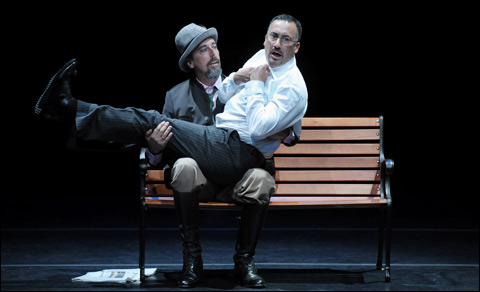
DISIDENTIFIED: Watching the movie of The Sound of Music might help you follow Fräulein Maria — but not much. |
One thing you wouldn't expect from a Sound of Music parody is good taste. But Doug Elkins's Fräulein Maria (at the Paramount Theatre through October 3) is surprisingly sweet-tempered and only mildly raunchy. Instead of mocking the Rodgers & Hammerstein classic, Elkins sifts its kitschy apparatus down to a lovable revue, with music, dancing, and unconventional role playing.
Elkins, who conceived and choreographed the show, takes his musical text from the 1965 Julie Andrews movie. By that time, the story of the Trapp Family Singers had already been repurposed a few times, beginning with the original Maria's own book. The singing ensemble itself had disbanded by the time The Sound of Music opened on Broadway in 1959. In that version, Mary Martin was the Austrian girl who teaches seven fractious children how to sing, marries their straitlaced father, and turns the whole family into a vocal group who hike across the border just before the Nazi Anschluß, to gain their freedom and start a successful concert career.
The movie version has everything a postmodern demystifier could wish for, starting with the Alps, which are represented in the show as three rows of lumpy tarps. Julie Andrews's great singing and great looks may have sweetened up the real-life Maria, but Elkins takes care of this by more or less disidentifying everyone. The performers are listed alphabetically in the program, and with their gender thrown to the winds, most of them play several characters.
Meghan Merrill, whom I thought of as the "real" Maria because she dances the final duet with the Baron (Jeffrey Kazin), is shadowed most of the time by two alter egos (Donnell Oakley and Joshua Palmer). Deborah Lohse, when she isn't being a nun, plays Baron von Trapp's snooty girlfriend. The oldest Trapp daughter, Liesl, is David Parker, who does a barefoot softshoe when the children are introduced to their new governess and later has a rendezvous with the messenger boy. Rolf (Gui Greene) is wondering whether to join Hitler Youth, but that doesn't stop him from courting her with breakdance moves. Elkins himself, in black shorts and a hoodie with wimple, plays the hip-hopping Abbess.
If you're not following this, the movie might help. But not much. Fräulein Maria isn't really about the characters or the story — it's about how many different ways you can dance through a slim plotline, with layers of insinuation showing through at every turn. The action is non-stop dance, by all the principals plus five others who play the kids, the nuns, German brownshirts, and assorted townsfolk. Doug Elkins was fusing breakdance with modern dance long before it became standard practice. His work here, accompanied by the film soundtrack, is a mix of contemporary, hip-hop, ballet, social dance, jazz, sexual innuendo, and anything else that happens to slip in. Too fast to be dazzling and too funny for second thoughts.
As a dance show, Fräulein Maria makes its impact through visual recognition. Stage directors Barbara Karger and Michael Preston have backgrounds in major contemporary mime-puppet-circus companies — notably Mummenschanz and the Flying Karamazov Brothers — and the show moves with a manic disregard for realism or logic, let alone sentimentality. The jokes and turnabouts whiz past; before your brain can process a lewd gesture or a sudden reference to Martha Graham's anguished heroines, the dancers are speeding through their next flips or stomps.